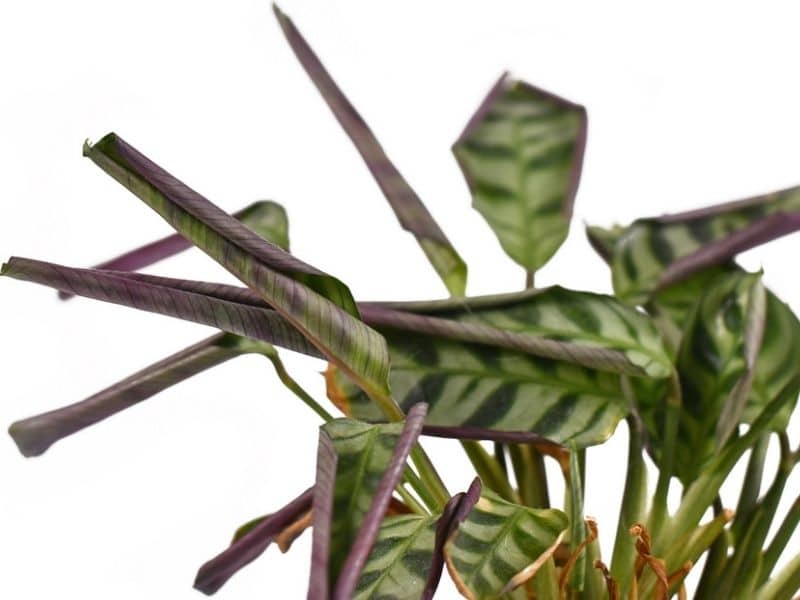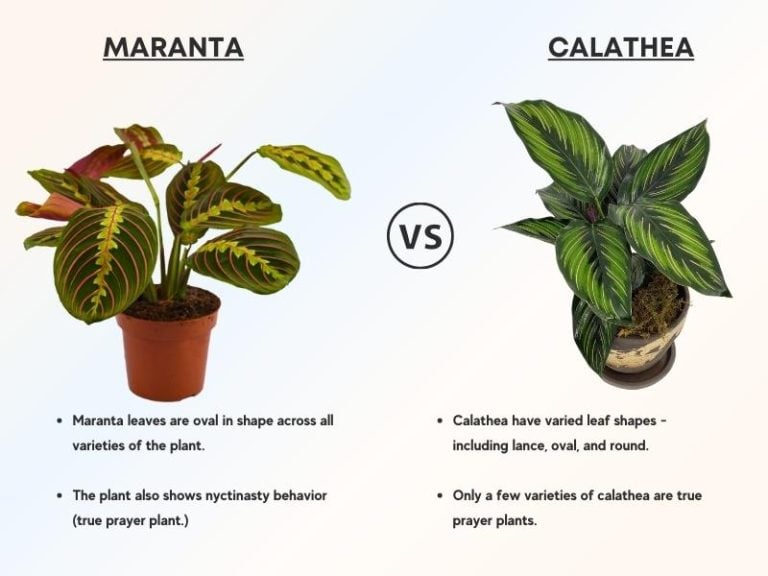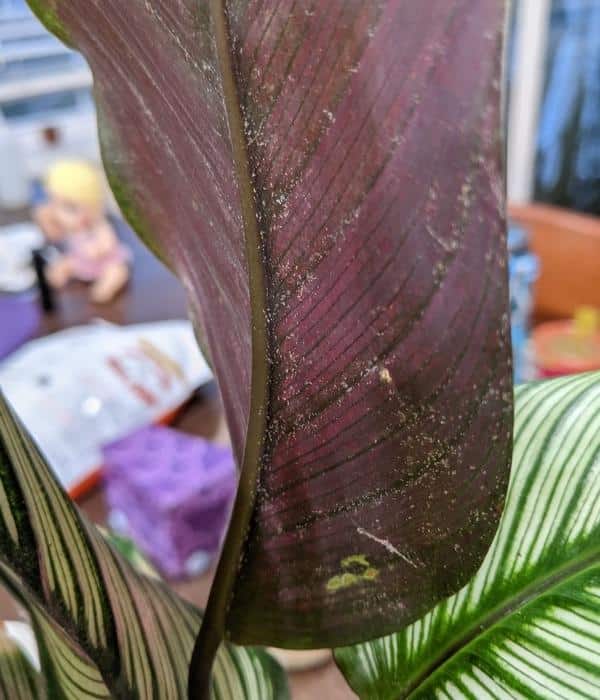Calathea Leaves Drooping: Causes + How to Save the Prayer Plant
The calathea plant (prayer plant) should have vibrant leaves when happy. During the night, these leaves will appear to move upwards but during the day, they get lowered. This is a sign of a happy calathea plant. However, when the leaves of your prayer plant start to wilt, it is a major sign something is wrong with the plant. But, what causes drooping calathea leaves?
Drooping calathea leaves are a sign of overwatering or underwatering. The prayer plant can also wilt if watered with tap water or when it is root-bound. Water your calathea only when the top 2 inches of the soil dries up and repot it using a bigger pot if it is rootbound to save the plant.
I’ve also found that when the leaves of calathea turn brown and appear weak, the prayer plant may also be experiencing a problem in the root zone, most commonly, excess salts or rotting roots as I’ve explained below.
Causes of drooping calathea leaves

Being tropical plants native to Brazil, Calathea thrives in similar or controlled environments. Balanced water, soil fertility, humidity, and light exposure are essential to their indoor success and beauty. Drooping means there’s an imbalance in important parameters.
Here’s why your calathea plant’s leaves are drooping:
Underwatering and overwatering
Forgetting to water your plant and enthusiastic watering are the leading causes of prayer plants’ drooping, wilting, and death. Transpiration continues whether you water the plant or not.
Underwatering makes the plant use more water than is provided in the soil. Conversely, root rot from overwatering can reduce water uptake and result in drooping leaves.
Excess fertilizer
Frequently fertilizing a prayer plant is effective only when you know the recommended volume of fertilizer. According to Penn State Extension, overfertilizing potted plants raises soluble salt concentrations in the soil medium. The salts clog roots, reducing the net flow of water to the calathea leaves and causing drooping.
Excess fertilizer also dampens and predisposes the plant’s roots to diseases. Subsequently, the lower leaves of calathea will turn yellow and the tips brown. The plant’s growth may eventually slow down to a halt. Therefore, wilting and drooping can be the early signs of over-fertilization.
Extreme light and temperature
Extreme light falls on either side of the spectrum: excess light and very low light. Exposure to too much light will fade, scorch, and dry the prayer plant’s leaves. If you grow it in direct sunlight, transpiration will increase significantly. In that case, drooping is a biological response to reduce the leaf area and limit water loss.
Whereas it can grow in low light, calathea plant leaves will equally droop in no light. Also, I do not recommend planting them at temperatures below 60°F. Low temperatures deactivate the biological processes that keep Prayer plants turgid, and those processes may shut down in scorching areas above 90°F.
Irrigation with tap water
The University of Massachusetts Amherst revealed that tap water has quality problems. Despite looking clean, the water is full of dissolved mineral salts with the same devastating effect on calathea roots as excess fertilizers.
White rings around the potting soil are evidence of excess salts in the water. Continuous build-up of mineral salts such as chlorine and fluorine will cause burns, leaf browning, and drooping of calathea leaves.
Low humidity
Prayer plants thrive in humid environments like their native tropical homes. Reduced humidity has a significant impact on its glossy leaves. Remember that calathea also uses its leaves to absorb moisture from the surrounding. If the air is too dry, the plant will be surviving instead of growing and may eventually sag and die.
Pests and diseases
Another commonly overlooked cause of drooping calathea leaves is pests and diseases. Perhaps the infestation may be too tiny to identify with naked eyes or because the plant is not poisonous to pests.
Mealybugs and aphids use their proboscis to suck away sap from indoor prayer plants, leaving behind drooping foliage. White fluffy cotton-like patches that appear from nowhere are a sign of mealybugs.
Another common problem is a spider mite infestation on calathea. These multiply fast and can spread to other plants if not controlled.
If left untreated, calathea may droop or die.
Physical damage
Physical damage can occur to indoor Prayer plants more frequently than you can imagine. Family members, visitors, or even you may occasionally damage the plant stems and leaves. Destruction of a stem can limit the water and nutrients uptake to the leaves, causing them to wilt and die back.
Rootbound
A prayer plant can take between two and three years to mature, during which time it can grow about two feet tall. The root may have formed a large tangled mass exceeding the pot during that time. If that is the case, you will notice some roots escaping through the drainage holes or protruding above the potting soil.
Bound roots can cause drooping in calathea leaves as it exposes the roots to air, ridding the plant of access to soil nutrients and water.
Root rot disease can also invade calathea, hinder water uptake to the leaves, and cause wilting.
Note: A specific cause may be the reason for the drooping of your calathea plants. However, sometimes it may be a combination of two or more of the causes aforementioned.
How to revive a droopy prayer plant
The right fix for your drooping prayer plant will depend on the main cause of the problem. You want to make sure you’re fixing the right problem. For the most part, you may need to repot the plant especially if it is drooping because of root rot or excess fertilizer.
Here’s how to save an overwatered calathea:
1. Water when the soil dries up
Since erratic watering is a major cause of wilting and drooping in prayer plants, the best remedy is to time your watering sessions correctly and provide enough water. Water calathea once a week and only when the top two inches of its topsoil is dry.
To avoid underwatering or overwatering, set a reminder on your phone or use watering globes to help keep the soil in the pot moist for up to 14 days.
2. Move the plant to a spot with bright indirect light
Prayer plants prefer bright indirect sunlight. If your plant is receiving prolonged direct sunlight for more than eight hours a day, you can use a curtain to filter the excess light.
Similarly, moving calathea away from the windows can ensure it receives medium light. Concerning temperatures, maintain between 65 and 80 for a happy calathea plant.
3. Apply fertilizer sparingly
Apply a 10-10-10 NPK fertilizer on your calathea every four weeks especially during spring and summer when the plant is actively growing.
Water the plant first before applying fertilizer, otherwise, applying on dry soil will burn the plant’s roots and cause drooping foliage instead of doing so on dry soil, which would otherwise burn the plant’s roots and cause drooping again. I’d recommend you schedule the fertilizing as well to avoid overfertilizing.
4. Water the plant using rainwater
Tap water will eventually cause drooping in calathea plants, which is why I recommend using rainwater or distilled water. This type of water does not contain any salts or minerals that affect the plant.
If you cannot harvest enough rainwater, draw tap water and let it rest for 24 hours. Afterward, you can use it to water your prayer plants.
Alternatively, use distilled water and bottled spring water to keep your plant happy and healthy throughout the year.
5. Increase humidity to 50%
Humidity levels of 50% or more will keep the prayer plant at optimal growth. Since keeping the entire house at that humidity level is challenging, you can use a plant humidifier.
Ensure the plant is constantly moist by placing the pot on a tray filled with three inches of water to keep it constantly moist. Constantly monitor and refill the trays when the water runs dry.
Tip: Plant several tropical plants together for their transpiration to keep them humid.
6. Kill any pests on the prayer plant
Control mealybugs, spider mites, and aphids using mild pesticides such as pyrethrins and insecticidal soaps suited for ornamental plant pests. Organic pesticides are harmless to people and pets.
However, when pest and disease infestation is extreme, you should discard the plant alongside the soil and the pot.
7. Repot the plant
If your plant was drooping due to being rootbound, repot it using a bigger planter to provide additional space for roots to grow. I’d recommend a container two inches larger than the previous one when repotting plants.
However, repotting will also result in the drooping of calathea leaves for a while before the plant revives.
SEE ALSO: 13 Most Beautiful Varieties of Calathea
Why is my calathea drooping after repotting?
Drooping after repotting can happen due to mishandling, transportation, or exposure of calathea roots to air. Drooping can be visible in minutes as rootlets dry out and die. Another major cause of drooping in calathea after repotting is the differences in soil variables such as fertility and moisture.
Although you may not save the prayer plant from drooping 100% after repotting, you can increase the plant’s survival rate.
Here are a few tips to save a drooping calathea after repotting:
- First, prepare a flat surface in the shade to perform the procedure.
- Mix 40% moist perlite to 60% moist houseplant potting soil.
- Transfer your plant to a two-inch larger pot and use your hand to return the prepared soil carefully.
- Prune the lower dying leaves, so the plant concentrates its energy on growing new foliage.
- Finally, Irrigate until water flows from the drainage holes and fertilize your plant.
READ NEXT:
CALATHEA VS MARANTA – HOW TO TELL THE DIFFERENCE
References
- University of Georgia Extension: Growing Indoor Plants with Success
- R.T. Poole, A.R. Chase, and L.S. Osborne, University of Florida IFAS: Calathea Production Guide




